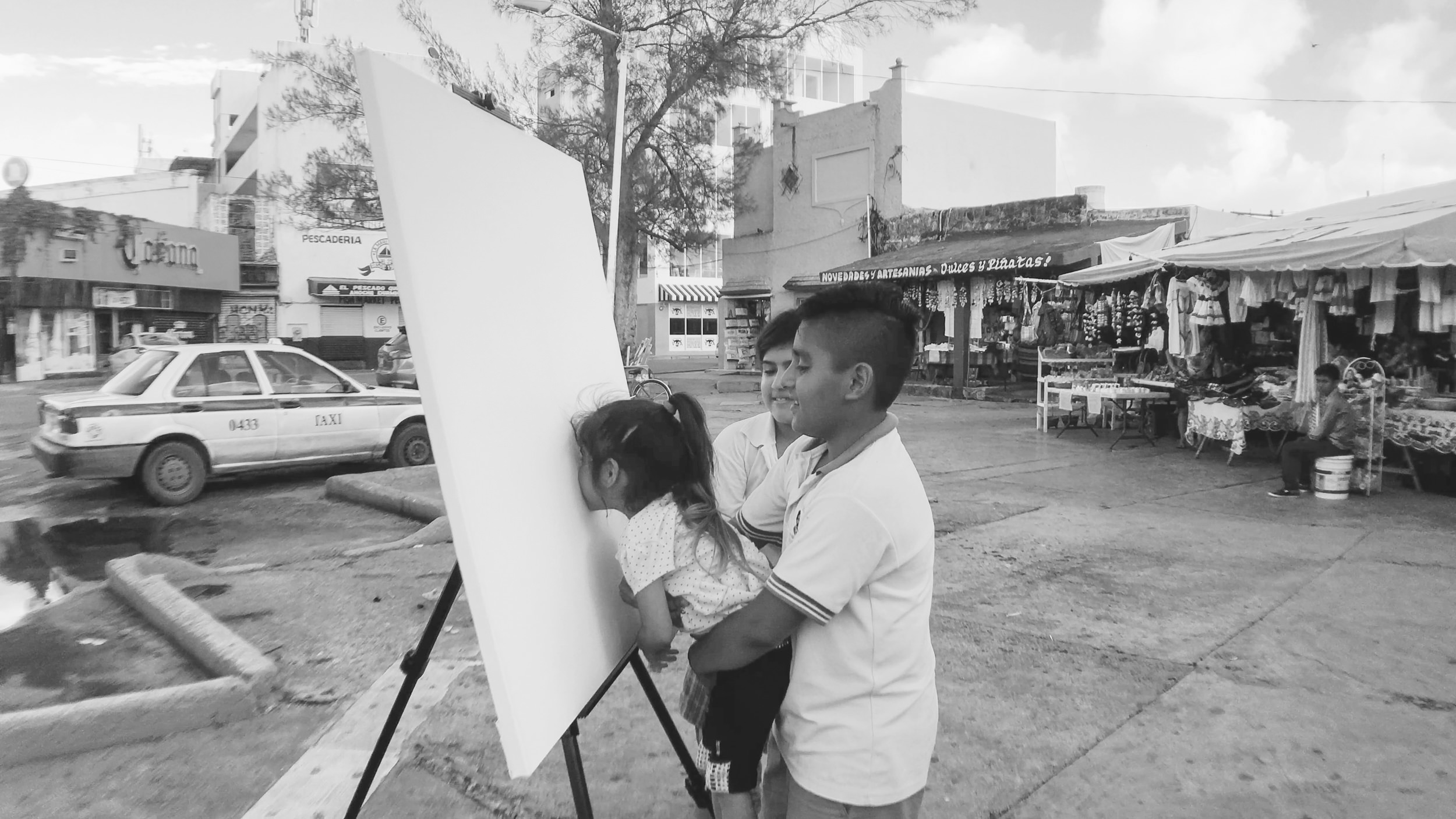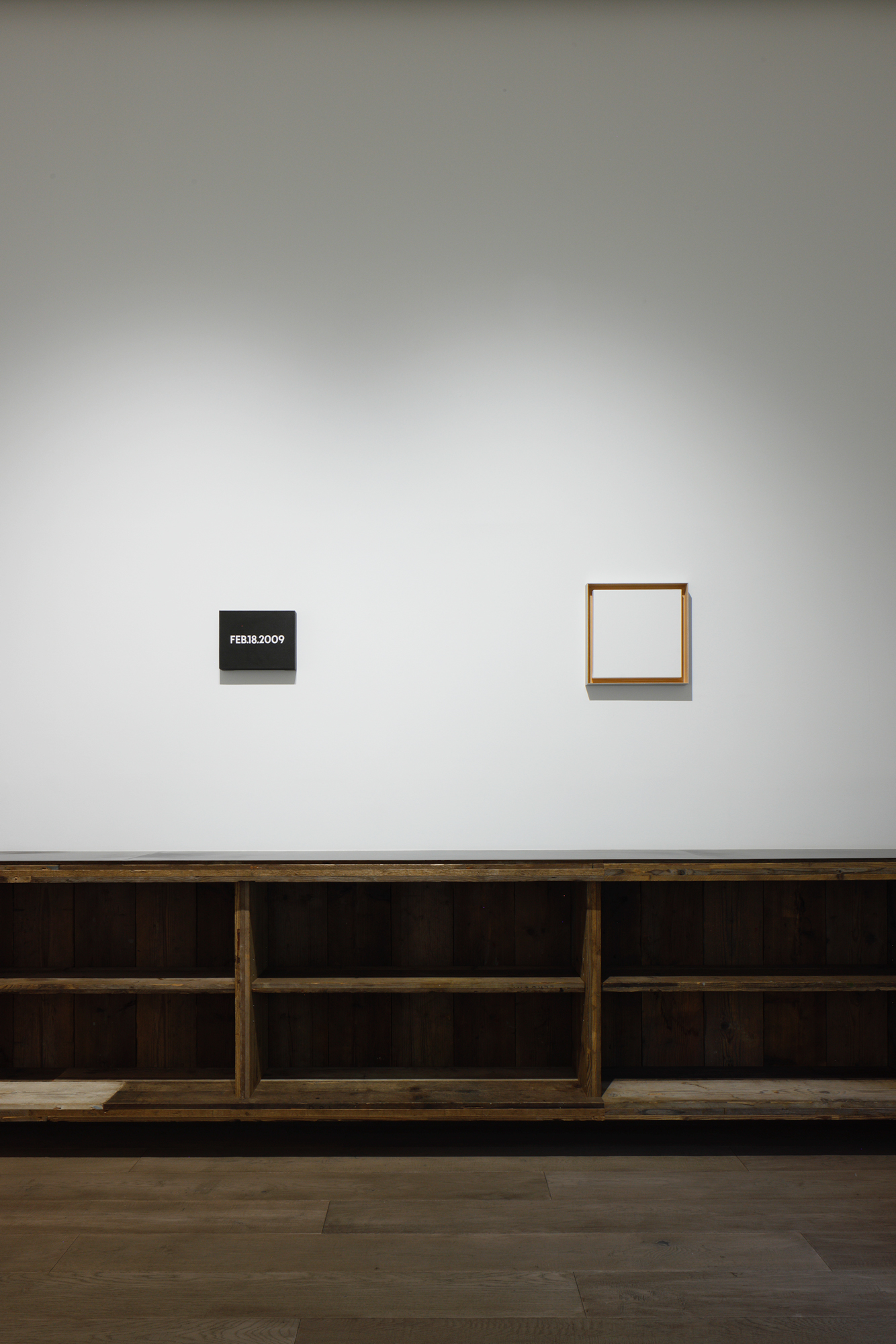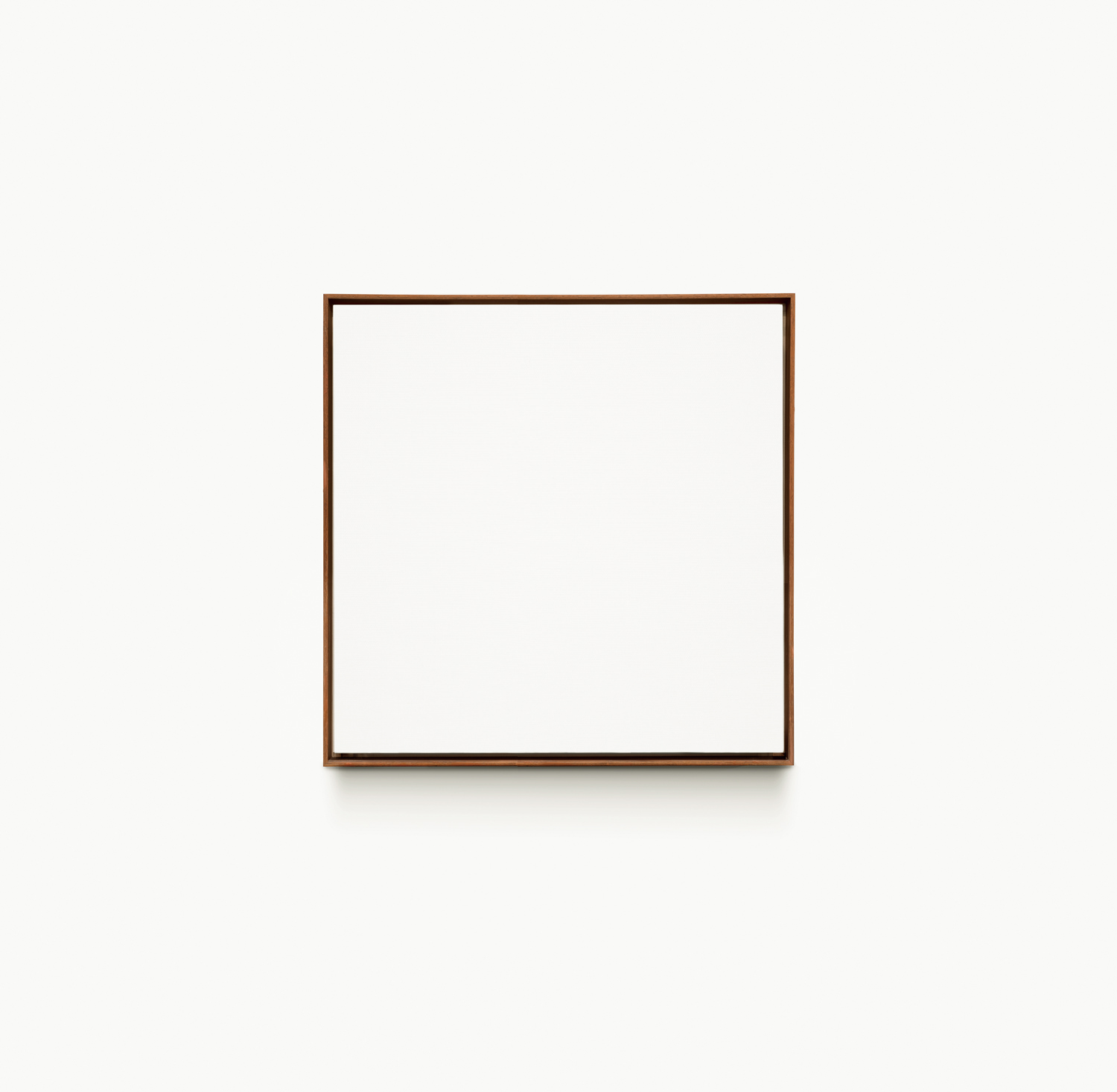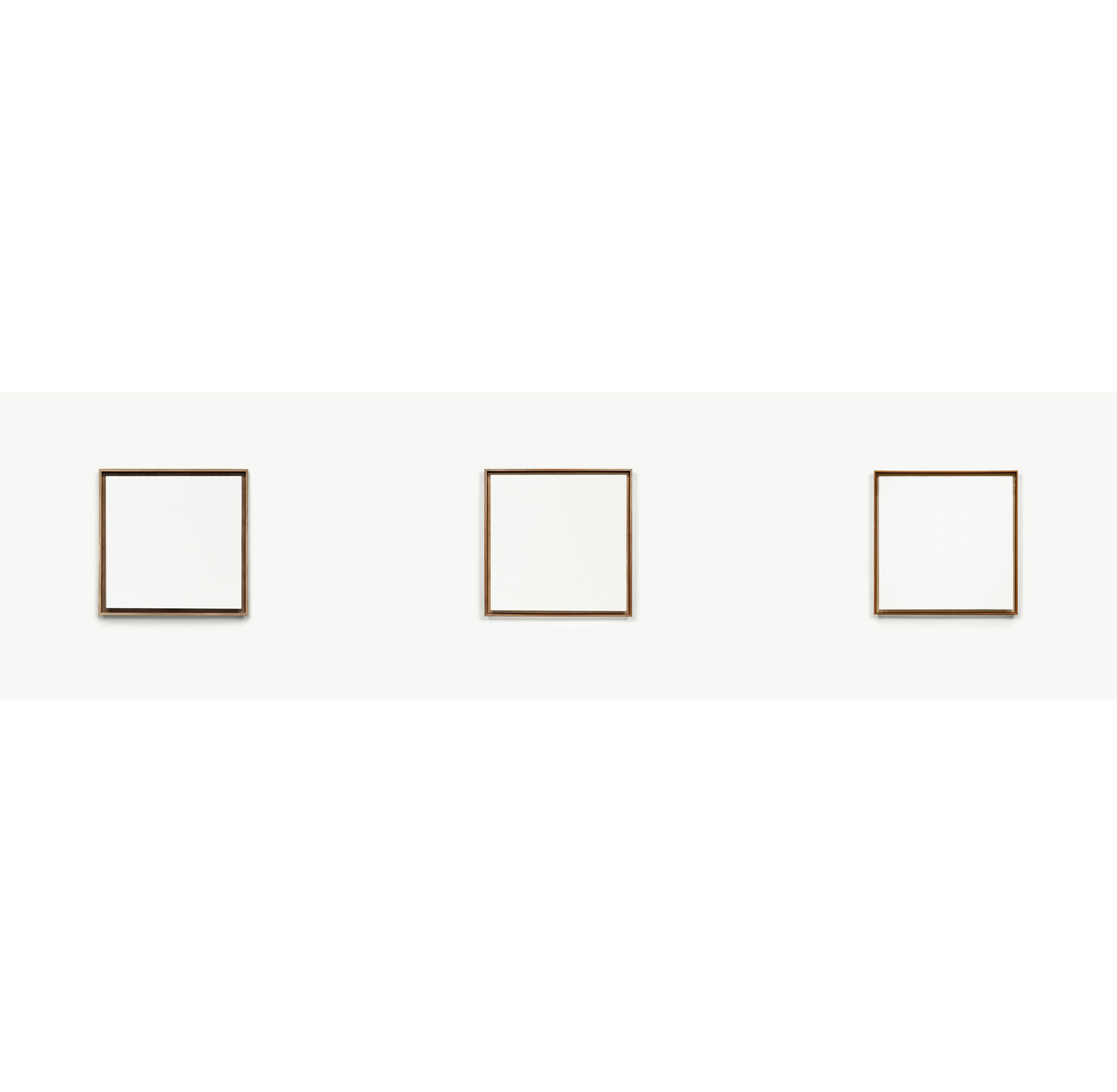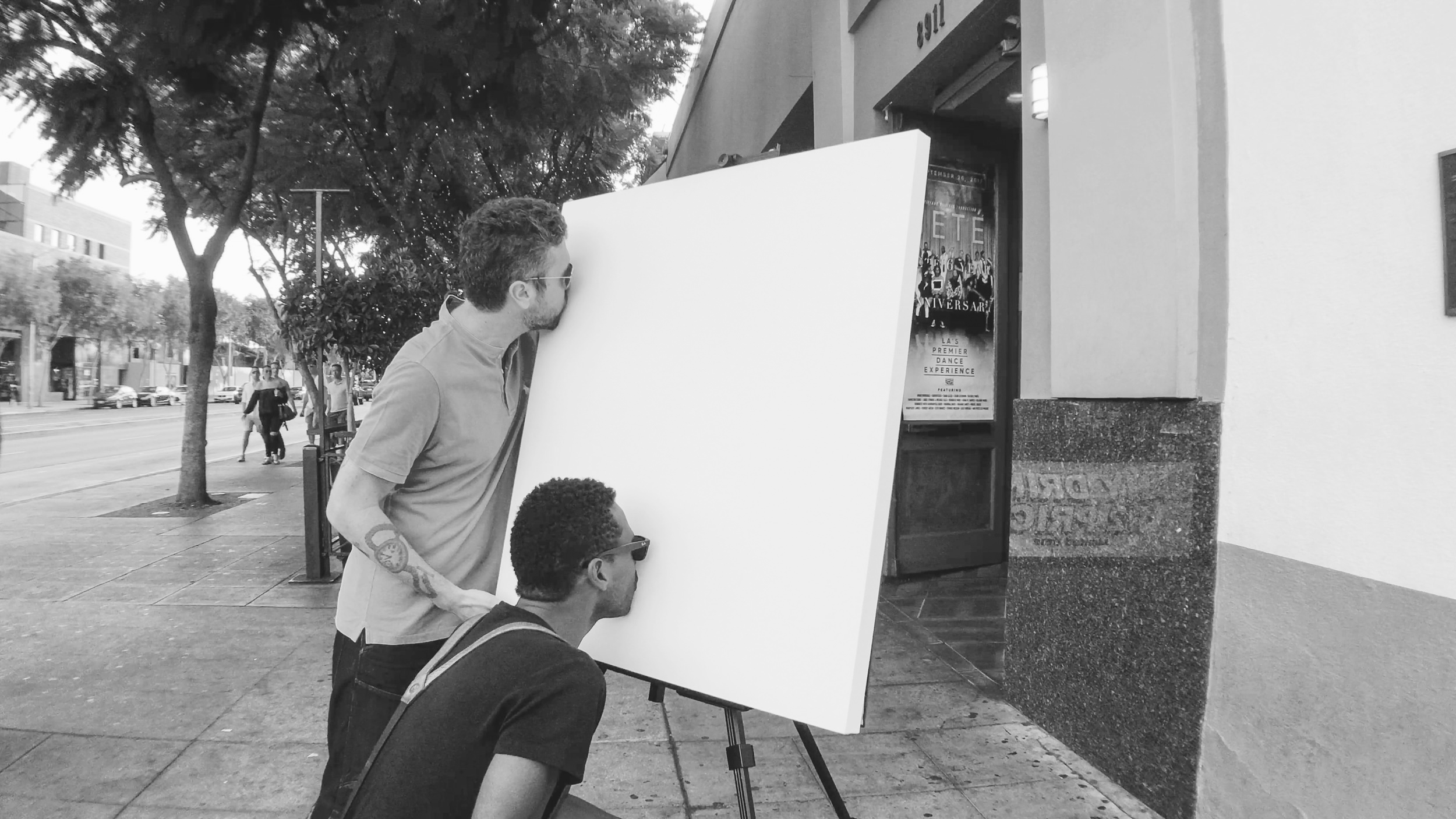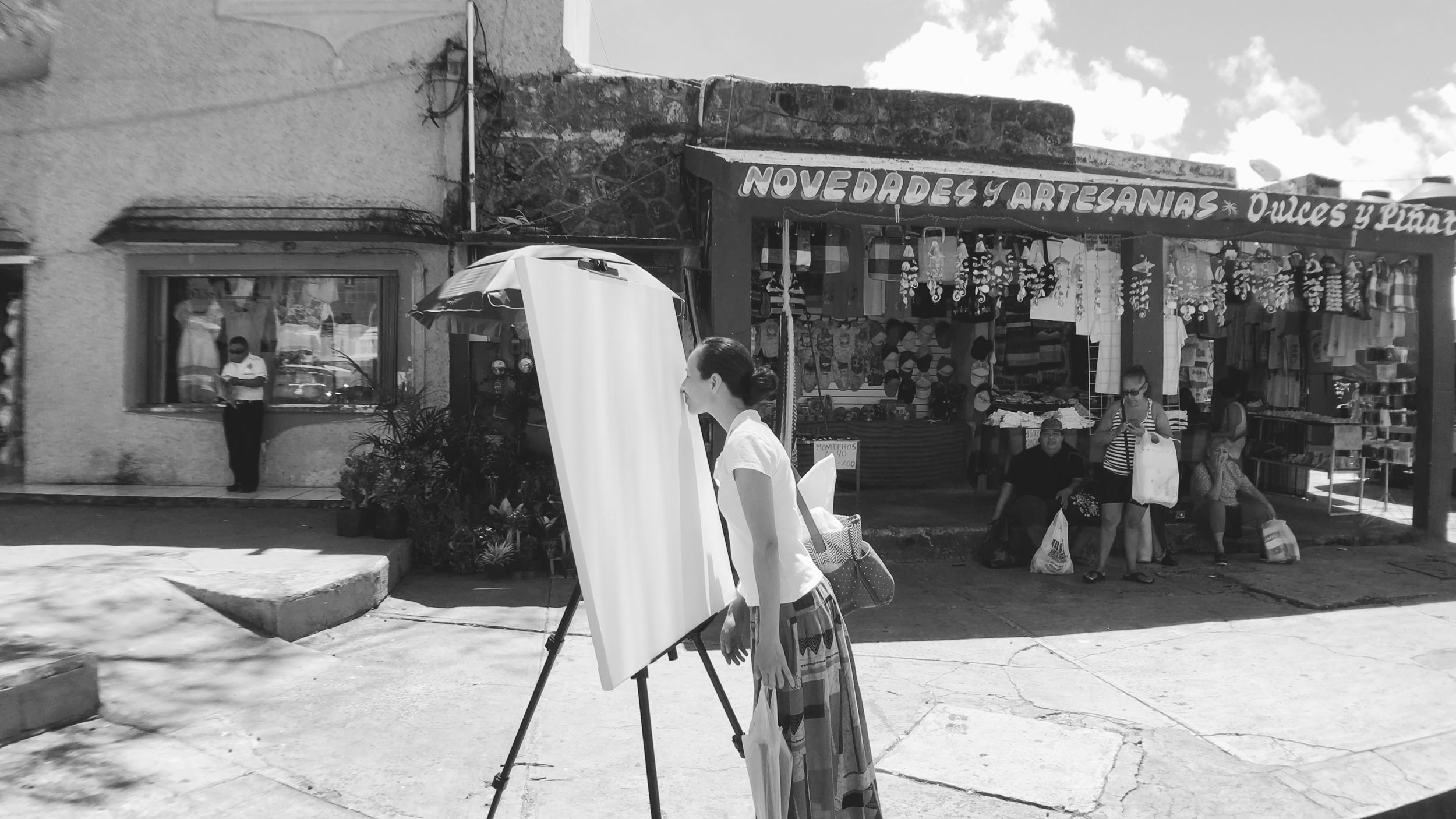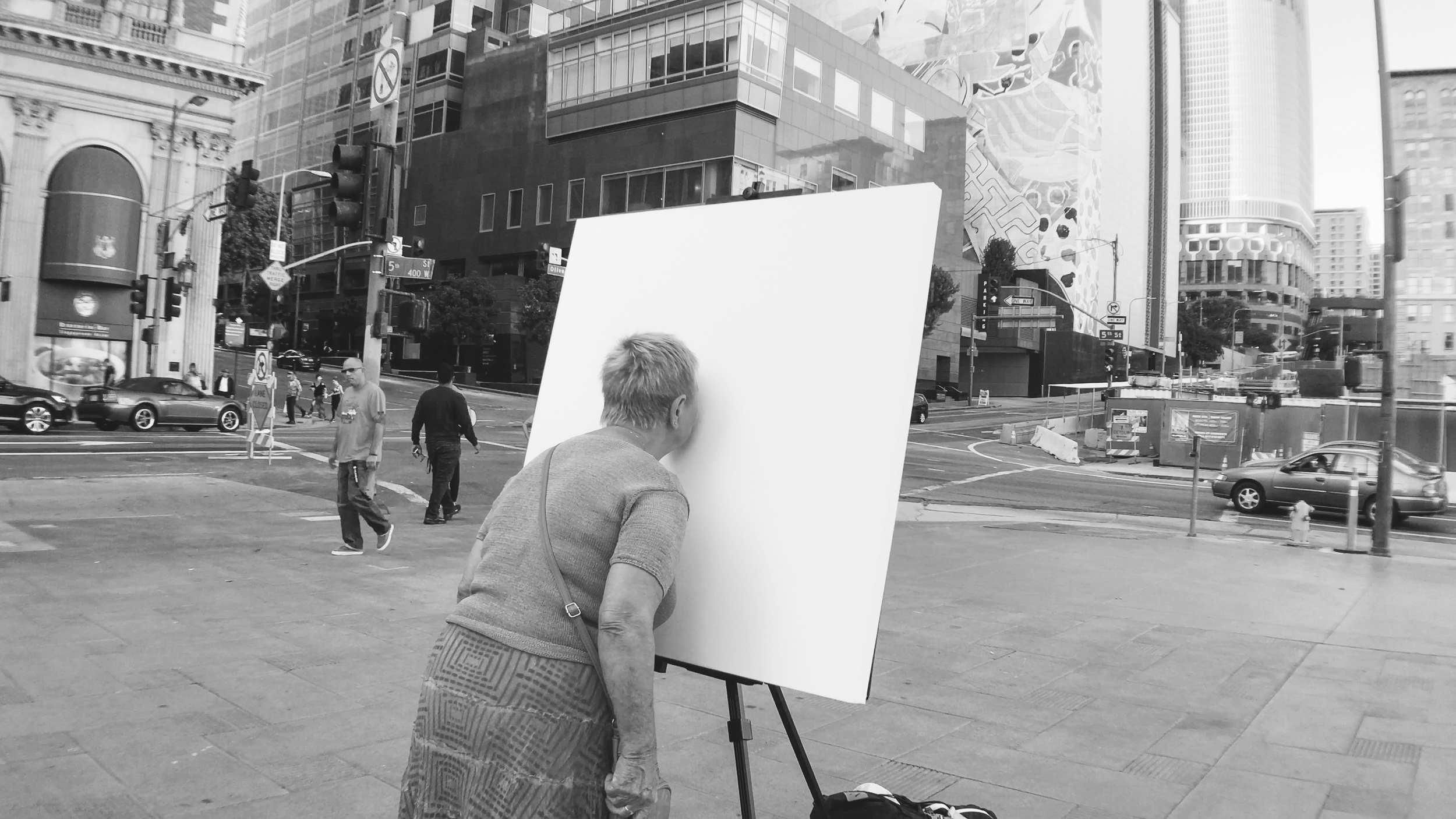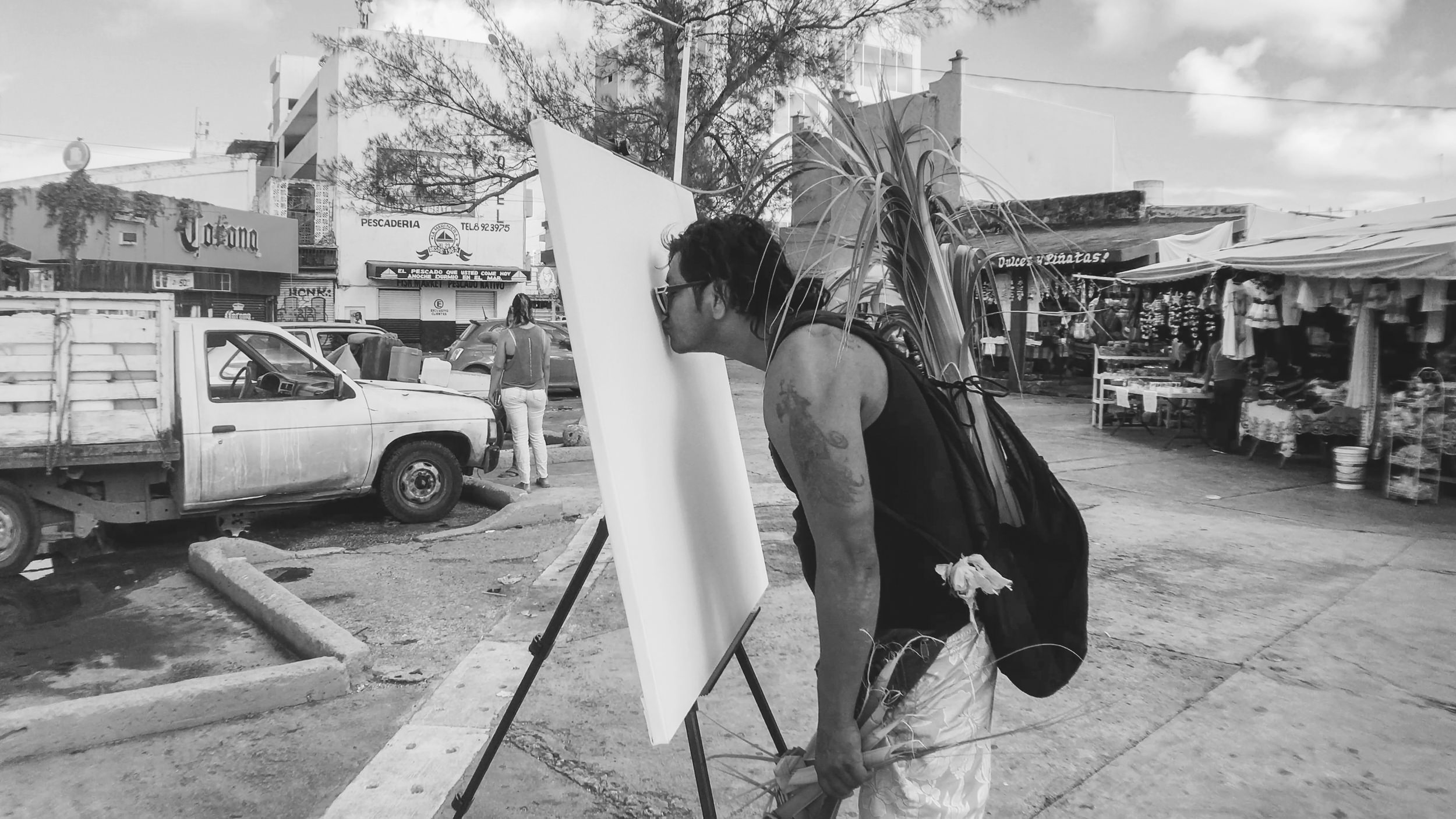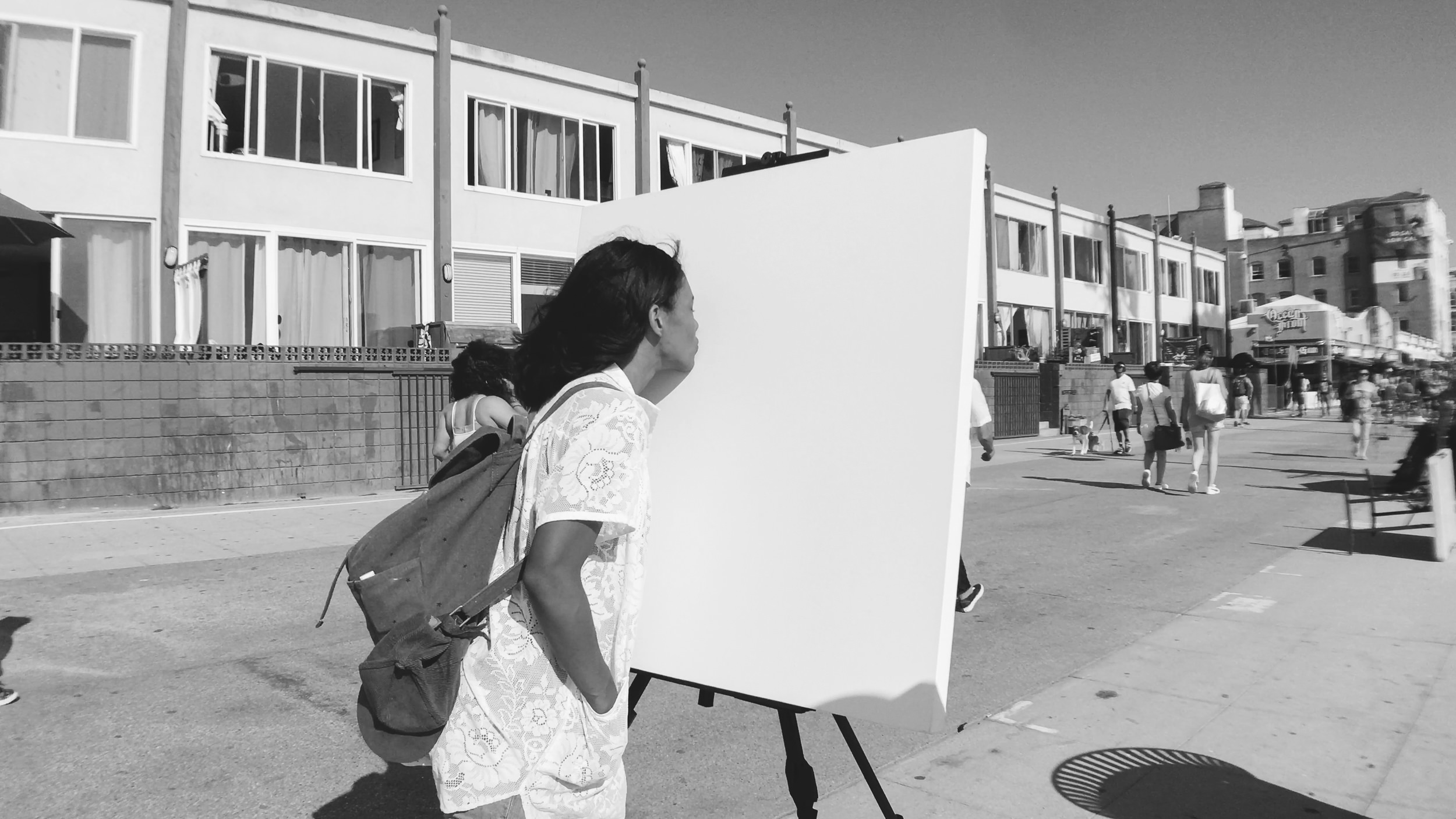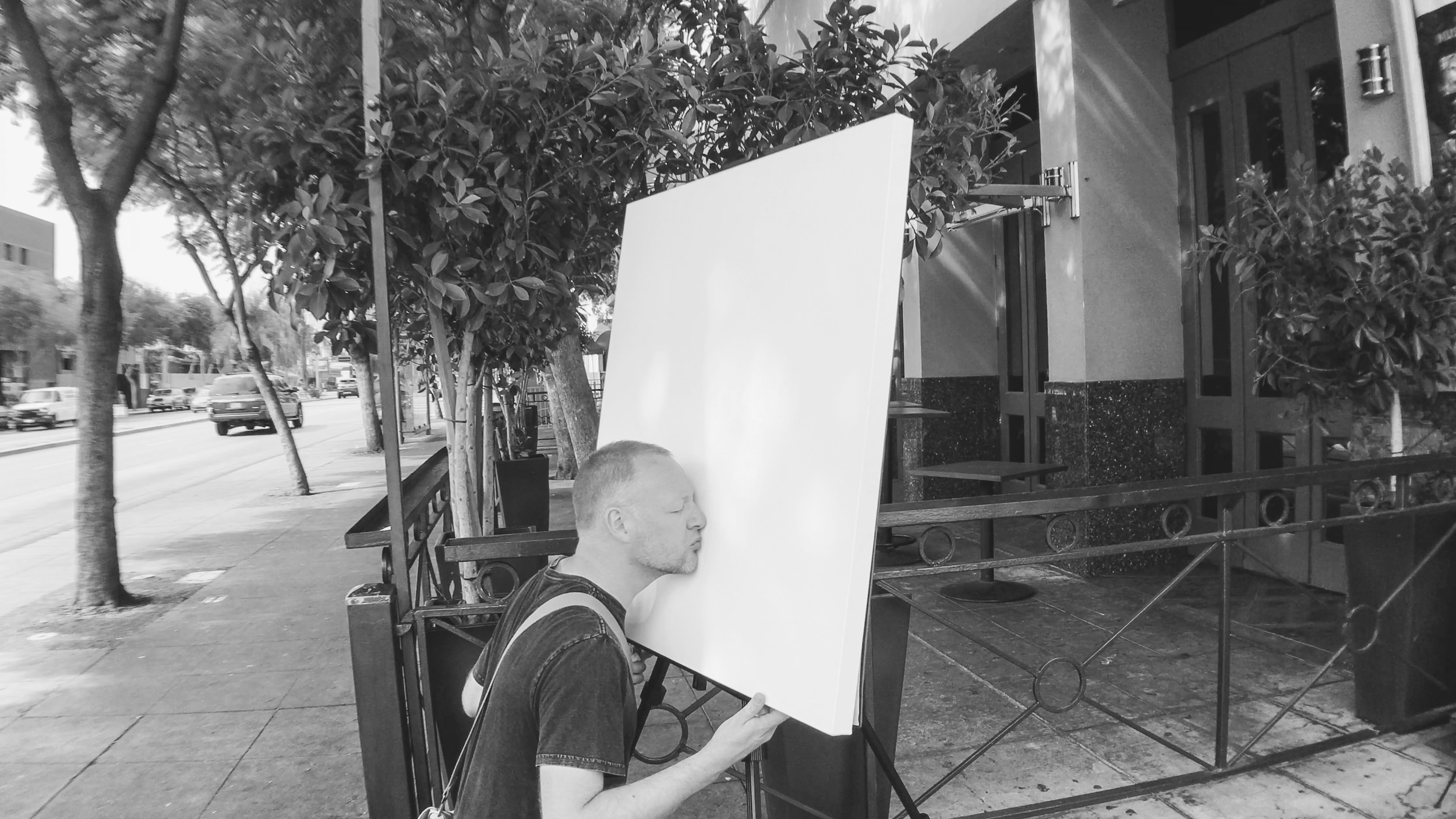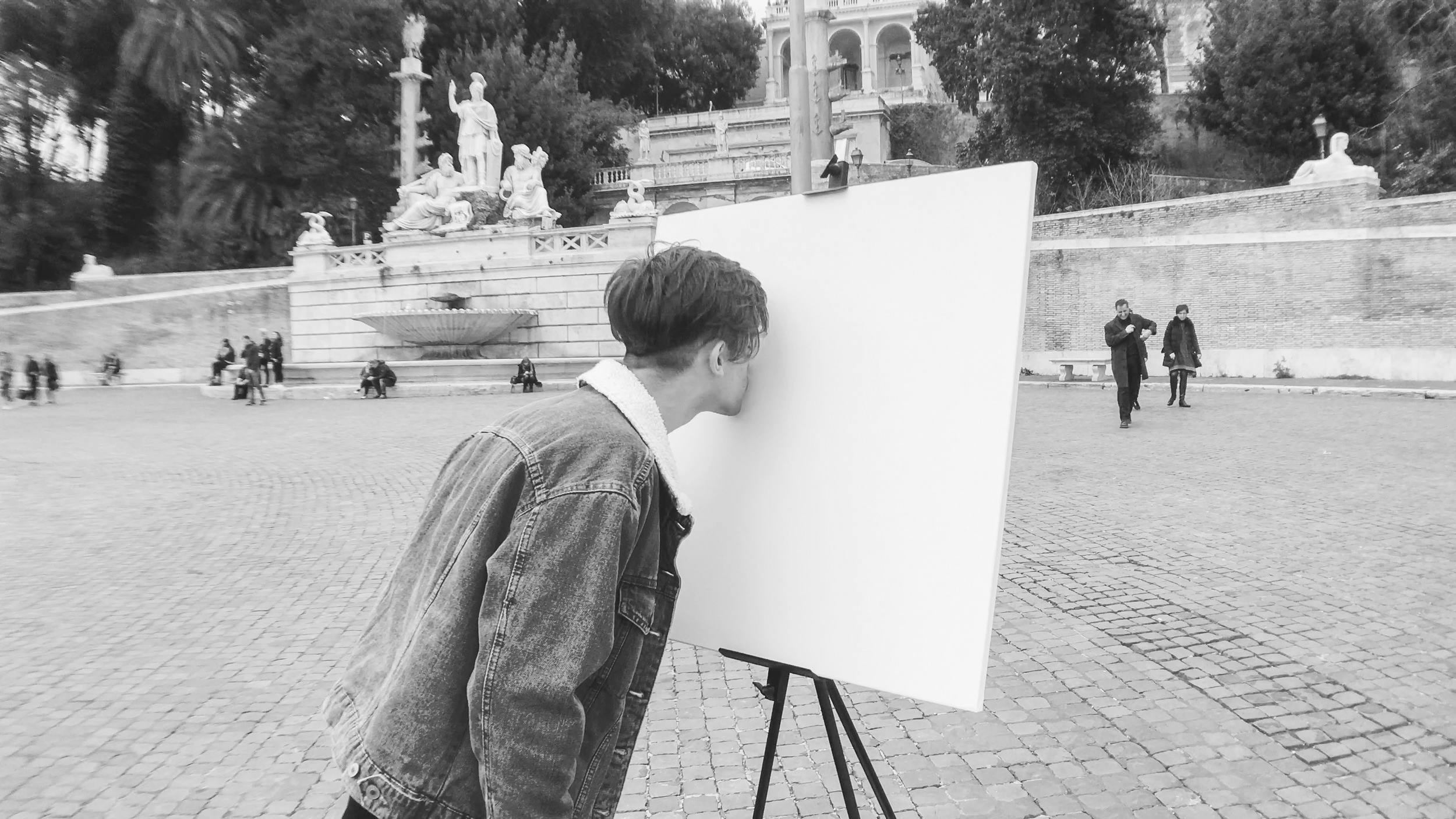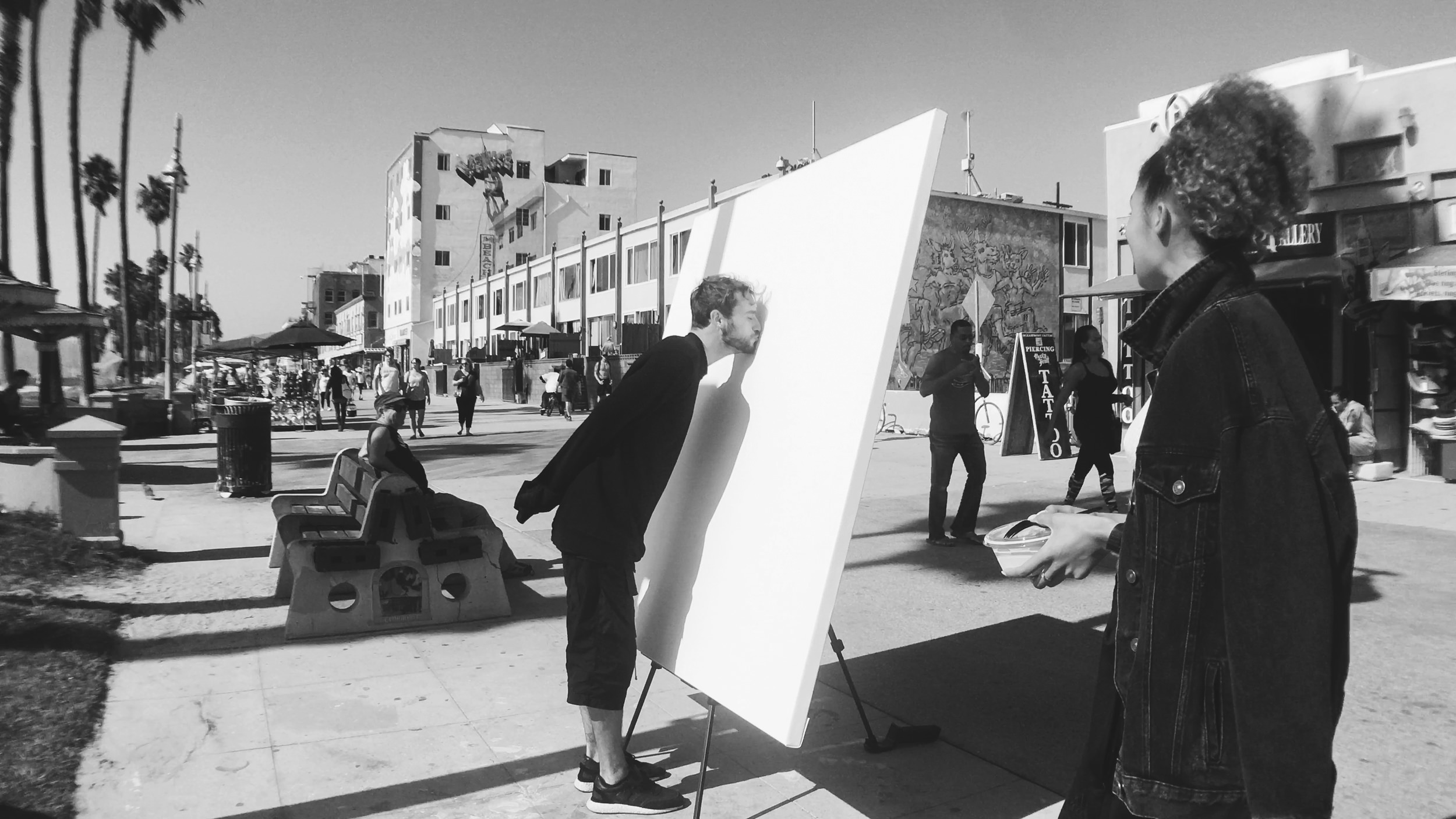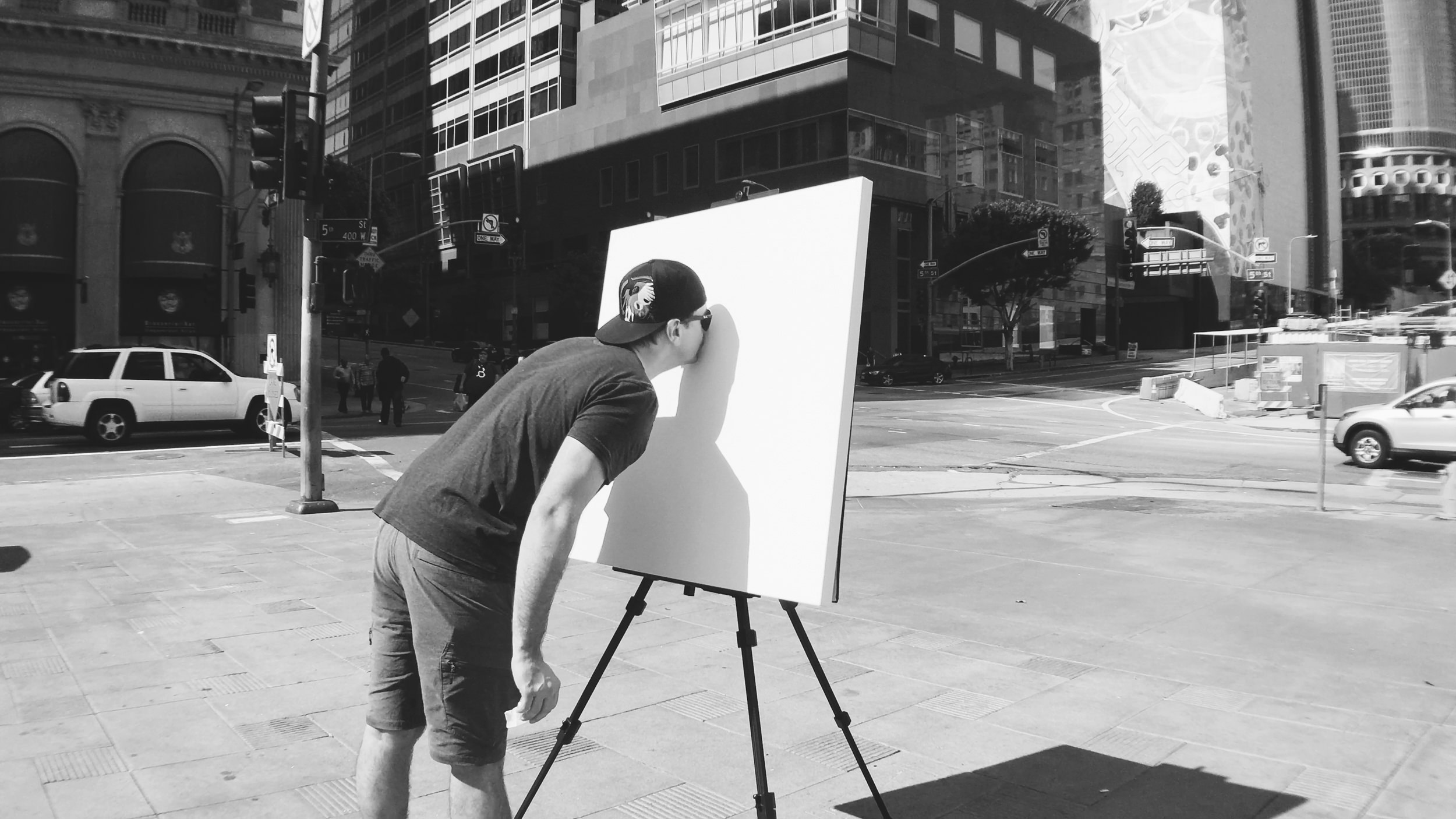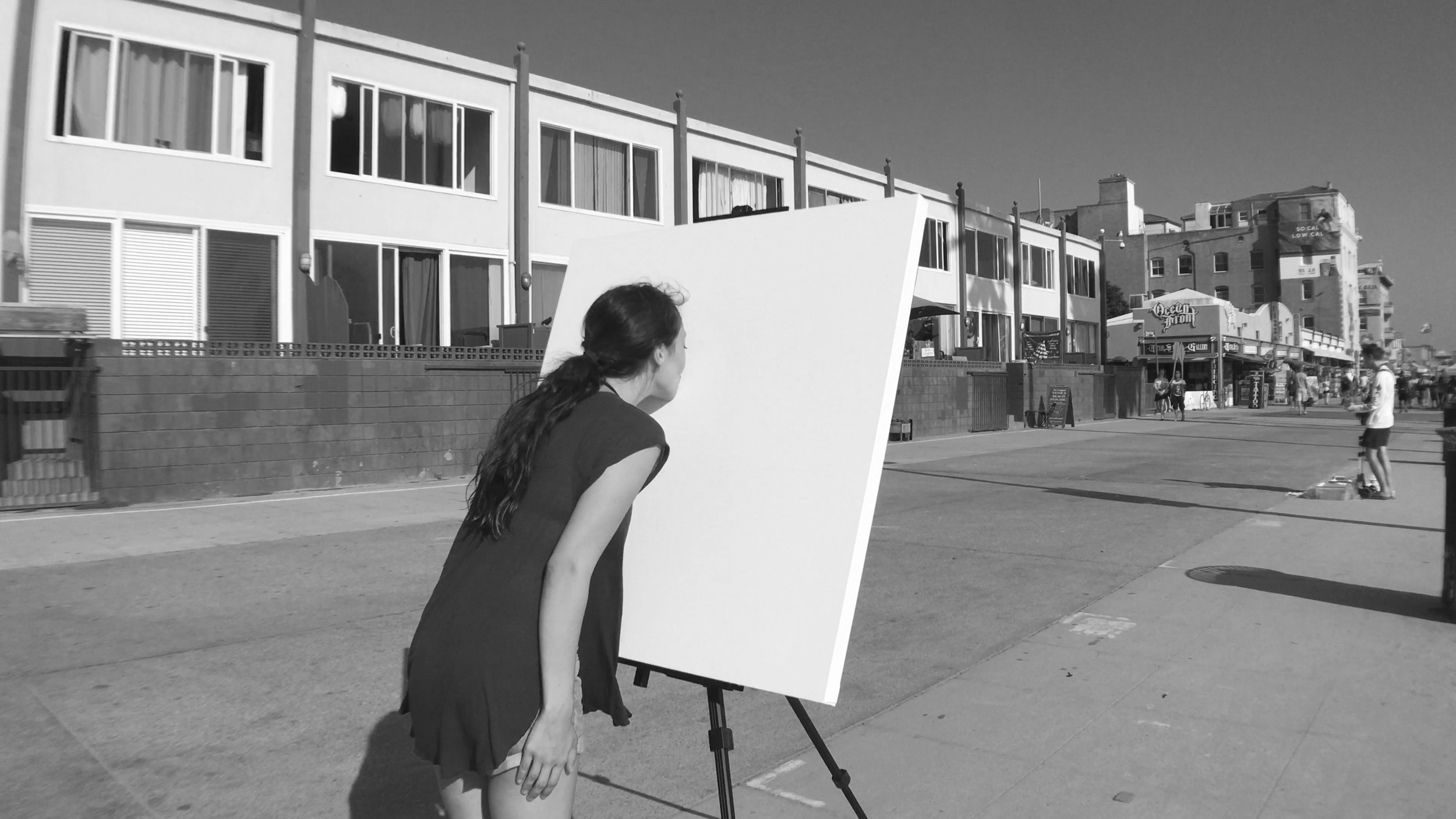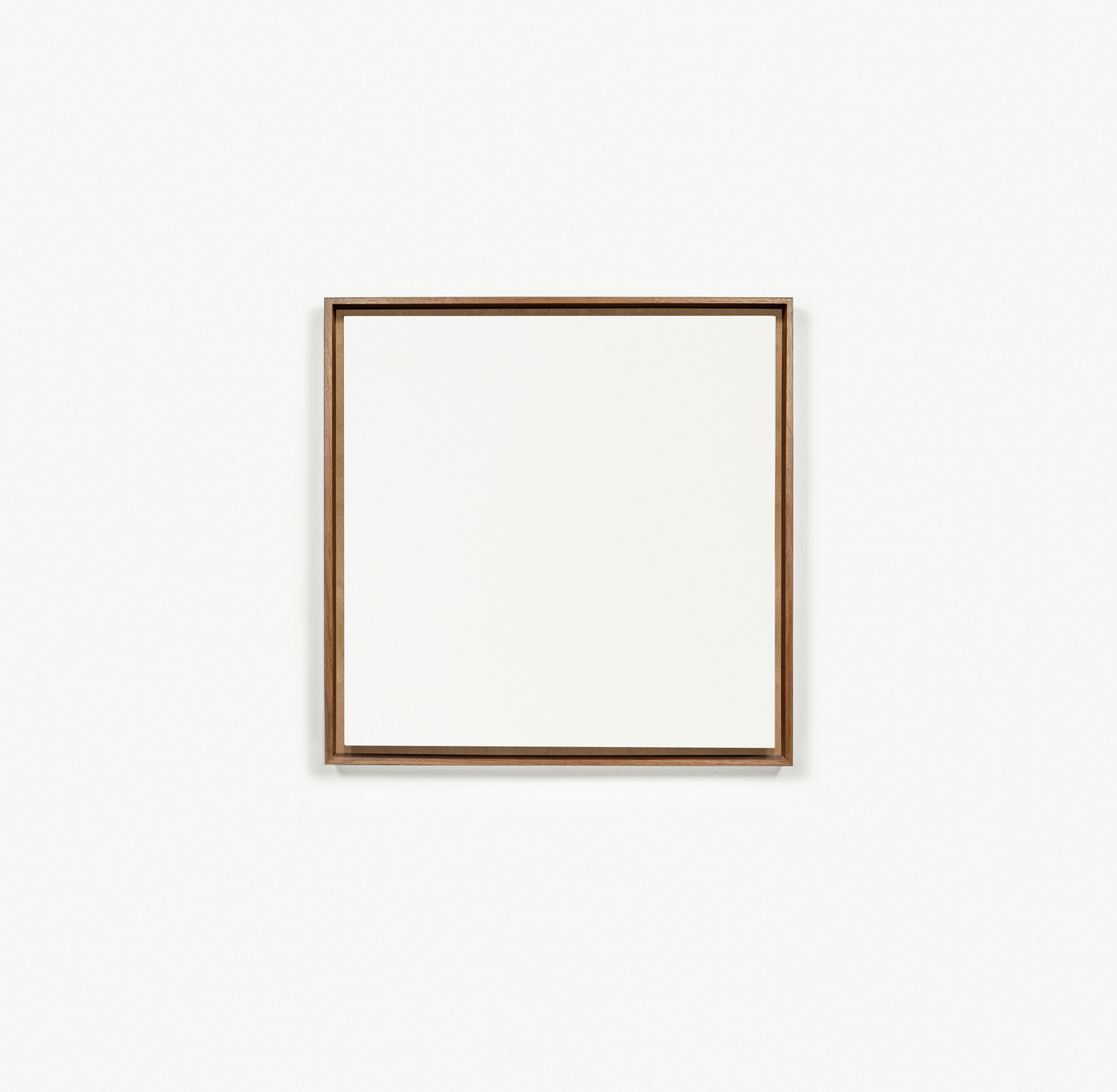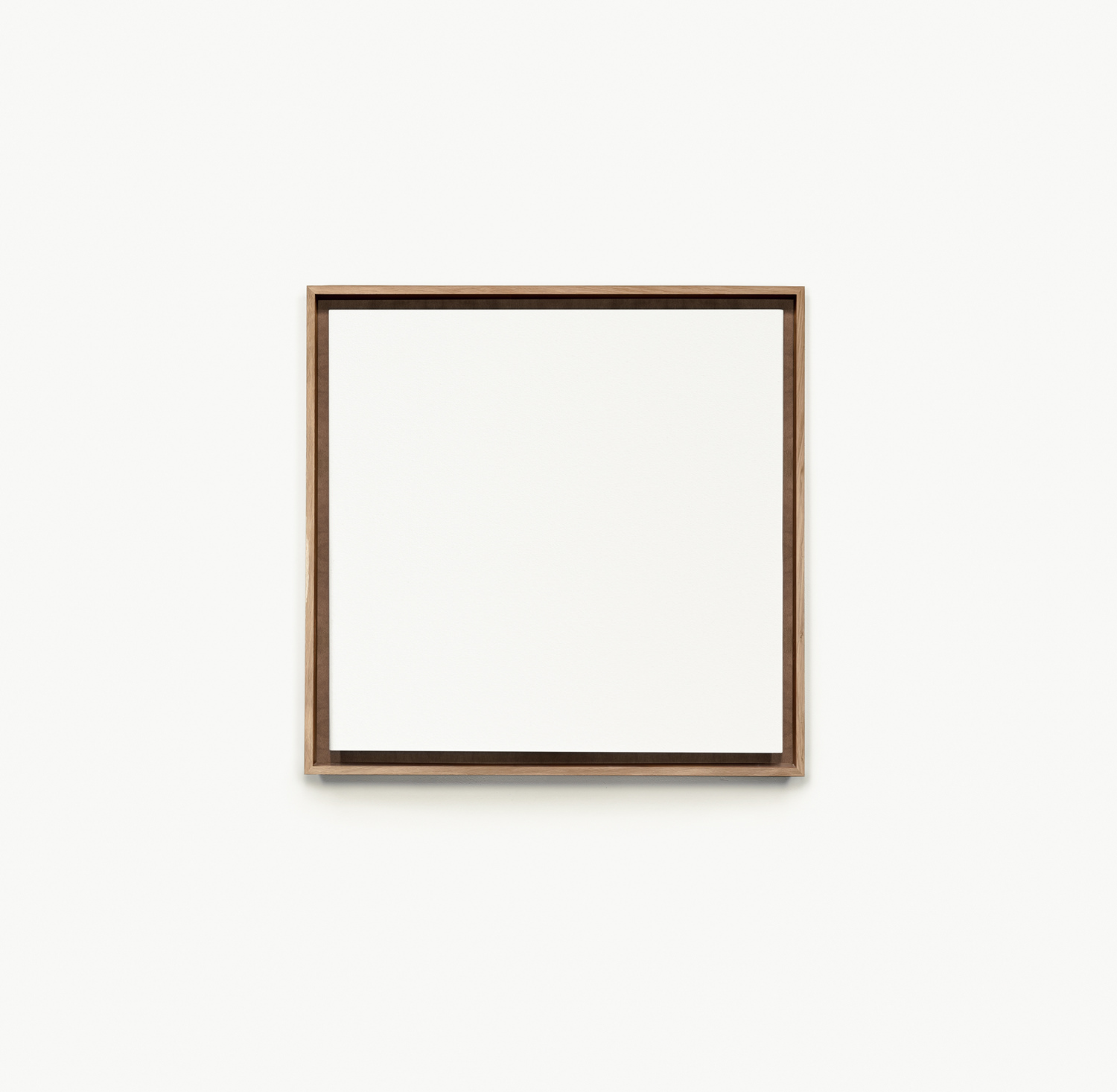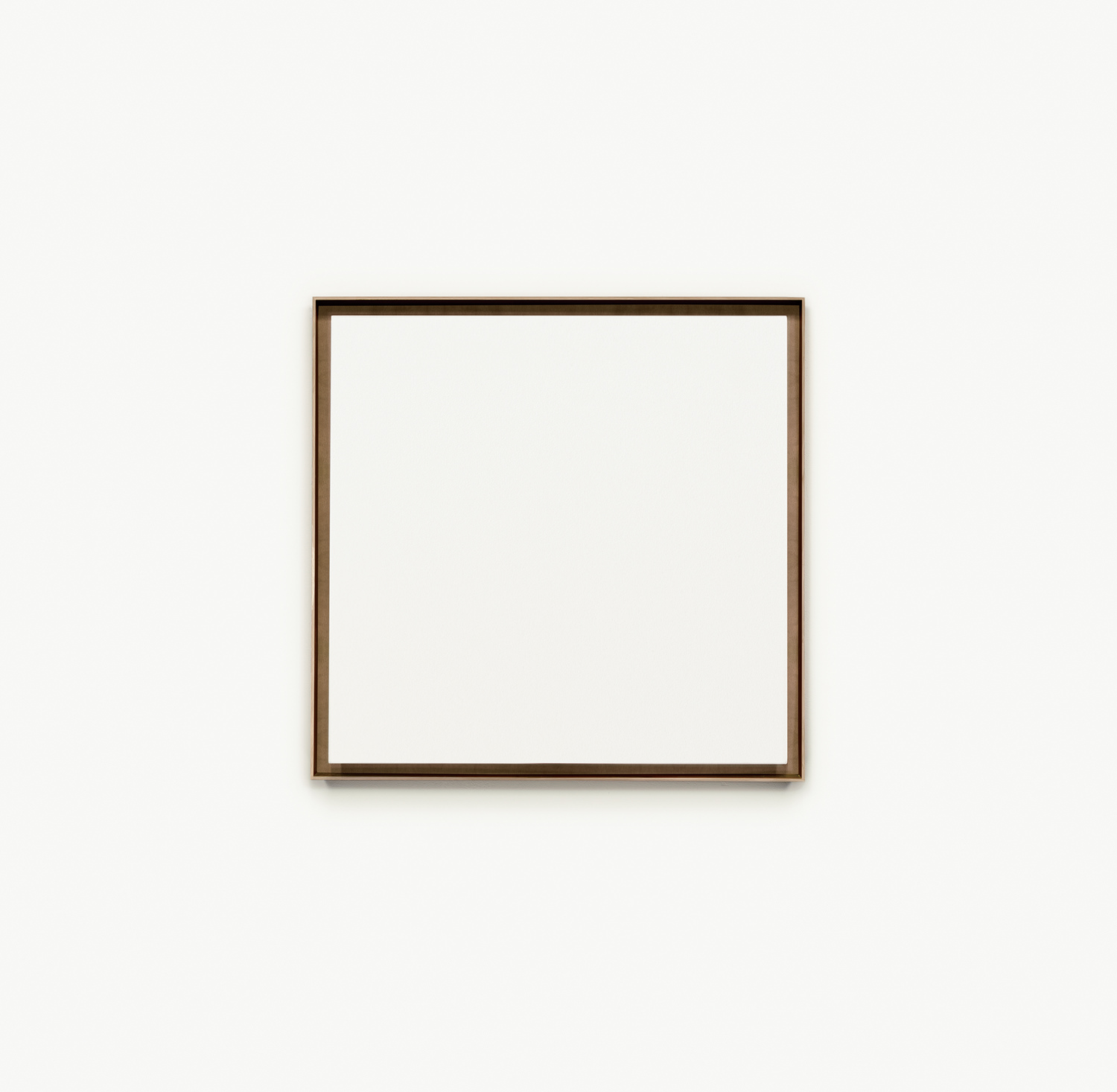Series of White Painting
2017–, Canvas.
“The canvas in the exhibit has no trace of paint or ink on it; however, it is impressed with the kisses of about 100 people. This work, which consists of asking randomly selected people around town– or by people in the specific community– to plant a kiss on the canvas, has been carried out in the USA, Mexico, Italy, Taiwan, Spain, and more, and the total kiss count has exceeded 600. This practice appears to be in stark contrast to the current divisiveness on a large, global scale, for instance the state, religion, ethnicity, and organization, as evidenced by Brexit, border walls, and refugee issues. It hints of the great promise of solidarity and reconstruction of globalization which is different from globalization, made possible only by small units of communities. ‘White Painting’ is a general title of this series, but each pieces is titled with the row of names of people who kiss on it.”
Quoted from a handout of “THE EUGENE Studio 1/2 Century later.”(Shiseido Gallery)
“THE EUGENE Studio’s White Painting series (…) transforming the canvases into nomadic shrines to love and memory…. White Painting series returns the monochrome to its iconic if uncertain place between a portal and a thing.”
By David Geers (an art critic who contributes his writing to October and among other places) in “Passion in Monochrome”.
Thesis
Passion in Monochrome
David Geers (Art critic)
Thesis “Passion in Monochrome”
David Geers (Art critic)
Quoted from a Catalog of “THE EUGENE Studio 1/2 Century later.”(Shiseido Gallery, 2017)
David Geers
David Geers is an art critic who lives and works in New York. His writing has appeared in October, Frieze, Fillip, BOMB, The Brooklyn Rail, The Third Rail Quarterly, among other publications. Often focusing on the convergence of painting, politics and technology, his recent works include: “Neo-Modern,” October No. 139 (Winter 2012), “Formal Affairs,” Frieze, No. 169 (March 2015) and “Acts of Recognition,” Frieze, No. 191 (November-December 2017).
“I have ripped through the blue lampshade of the constraints of colour,” wrote Kazimir Malevich on his White on White paintings in 1919. “Swim in the white free abyss, infinity is before you.”*1 Or consider Alexander Rodchenko, who, upon exhibiting his pivotal Pure Red Color, Pure Blue Color, and Pure Yellow Color (all 1921) boldly proclaimed: “I reduced painting to its logical conclusion and exhibited three canvases: red, blue and yellow. I affirmed: it’s all over. […] Every plane is a plane and there is to be no representation.” *2
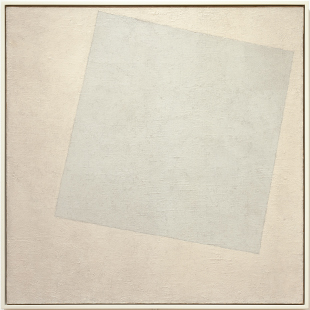
Fig.1 Malevich, Kazimir (1878-1935): Suprematist Composition: White on White, 1918. New York, Museum of Modern Art (MoMA). Oil on canvas, 31 1/4 x 31 1/4’ (79.4 x 79.4 cm). Acquisition confirmed in 1999 by agreement with the Estate of Kazimir Malevich and made possible with funds from the Mrs. John Hay Whitney Bequest (by exchange). 817.1935© 2019. Digital image, The Museum of Modern Art, New York/Scala, Florence
At the heart of this opposition resides the pivot—the passion—of the monochrome read as either an infinite portal or an unsparing wall. At least in the American context, the battle today appears won by the latter position, thus cementing the monochrome within its materialist aspect. But what does it mean to go in the other direction—from Rodchenko to Malevich? Or perhaps better still, to linger on the border between the two, thereby rendering painting’s transcendental promises as transportive and projected, as staunchly material and emerging from an affectively constituted network? These questions inform the complexity of THE EUGENE Studio’s White Painting (2017)—a trio of white, seemingly simple monochromes.
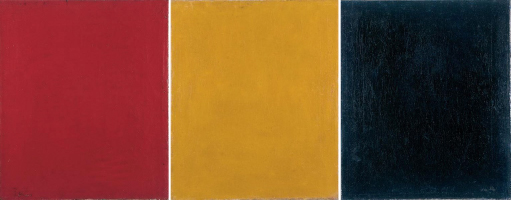
Fig.2 Pure Red Color (Chistyi krasnyi tsvet), Pure Yellow Color (Chistyi zheltyi tsvet), Pure Blue Color (Chistyi sinii tsvet). 1921. Oil on canvas. Each panel, 24 5/8 x 20 11/16” (62.5 x 52.5 cm). A. Rodchenko and V. Stepanova Archive, Moscow
Throughout the twentieth century the monochrome’s variegated history has registered the subtle operations animating this project. Although there is a sustained presence of the monochrome in twentieth-century East Asian art—one might think of the Gutai movement in Japan in the 1950s and 60s, the later Mono-ha movement, the Dansaekhwa style in Korea from the 1970s to the present, and various examples in Chinese art—THE EUGENE Studio’s “trinity” of monochromes also invites a Western reading embedded in Christian iconography, Minimalism and Conceptual Art. Such a genealogy foregrounds a shift from the religious to the autonomous artwork, then an exploration of its phenomenological status, and by extension, its constitution through language, external semantic frames and institutional structures.
More specifically, if Clement Greenberg’s theory of opticality demanded that painting refine its essence to paint on a flat surface—a color field that collapsed the aesthetic encounter with ocular perception while retaining the work’s illusionistic, transportive qualities—American Minimalists like Carl Andre, Donald Judd and others read this operation literally, reducing the artwork to a mere object. Within this tug of war Frank Stella initially appeared to be Minimalism’s herald (and eventual apostate), who shifted the modernist color plane promising transcendental “grace” into an obdurate thing resembling many industrial, modular objects littering our banal existence. *3
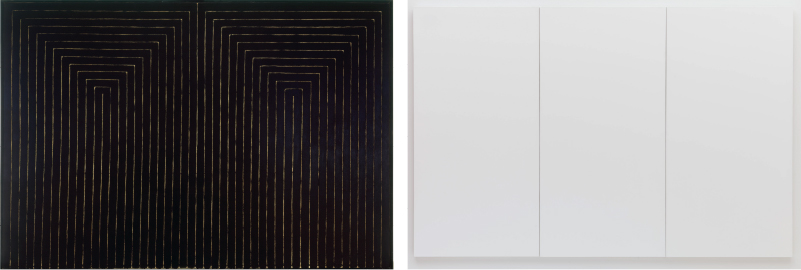
[Left] Fig.3 Stella, Frank (b. 1936): The Marriage of Reason and Squalor II, 1959. New York, Museum of Modern Art (MoMA). Enamel on canvas, 7’ 6 3/4’ x 11’ 3/4’ (230.5 x 337.2 cm). Larry Aldrich Foundation Fund. 725.1959 © 2019. Digital image, The Museum of Modern Art, New York/Scala, Florence [Right] Fig.4 Robert Rauschenberg, White Painting [three panel], 1951
For Robert Rauschenberg, a forerunner of these struggles, his White Paintings (1951) were, likewise, the ultimate riposte to Abstract Expressionist antecedents, substituting the New York School’s vaunted painterly gestures with seamless, replicable surfaces that registered the body of the viewer instead of the artist. Indeed, Rauschenberg’s white paintings were meant to be replicated and were throughout their exhibition history by artists such as Cy Twombly, Brice Marden, Hisachika Takahashi and Darryl Pottorf. Described initially by the artist, in the cosmic terms of his Ab-Ex predecessors, as “(one white as one God) canvases […] the plastic fullness of nothing, the point a circle begins and ends,” Rauschenberg would articulate them in the prosaic language of Minimalism some years later. “The wht [white] paintings were open composition by responding to the activity within their reach,” he said in 1968, receding from the void back to the white slates that John Cage famously called “airports for the lights, shadows, and particles.” *4
In Robert Ryman’s hands the monochrome underwent another earthly devaluation. “His paintings […] make visible the very mechanical activity of laying on the brushstrokes,” wrote the critic Douglas Crimp describing Ryman’s process, “as they are manifestly lined up, one after the other, left to right, row after row, until the surface is, simply, painted.”*5 For him, and the art historian Yve-Alain Bois later, Ryman brought painting closest to the mechanical operations of photography. The goal was to banalize painting, to rescind its transcendental claims, defrock it, and, should one still believe them, expose these claims as what Gerhard Richter called “pure idiocy.” *6
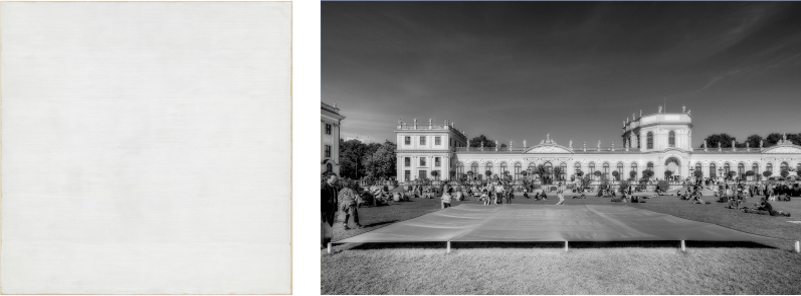
[Left] Fig.5 Ryman, Robert (b. 1930): Twin, 1966. Museum of Modern Art (MoMA). Oil on cotton, 6' 3 3/4' x 6' 3 7/8' (192.4 x 192.6 cm). Charles and Anita Blatt Fund and purchase. Acc. no.: 691.1971. ©2019 Digital image, The Museum of Modern Art, New York/Scala, Florence [Right] Fig.6 Tanaka Atsuko, Tokyo Work (1955), 2007 reconstruction at the documenta 12, Kassel, Germany. Rayon, 1000x1000cm.
But a different question lurks within THE EUGENE Studio’s White Painting series and its deceptively simple surfaces. Like Rauschenberg’s monochromes, the works are withholding, registering no incident or image but offering seemingly empty canvases instead. However, like Rauschenberg’s Cage-indebted practice, these works also encapsulate a performance, repeated in the US, Mexico, Taiwan, Italy and Spain, with more than 600 eager participants. At each site, THE EUGENE Studio set up the monochromes in a public space and invited passersby to kiss the paintings in the manner one might kiss a loved one or a Christian icon. Afterwards, many of the participants were asked about their feelings regarding love, each reflecting openly on the experience. Throughout, the entire ritual was recorded on an iPhone, with the resulting video then exhibited alongside the works on the same device, thereby transforming the canvases into nomadic shrines to love and memory.
Like Atsuko Tanaka’s context-sensitive Tokyo Work (1955), which, restaged at documenta 12 in 2007, registered the transient effects of its environment, and Rauschenberg’s monochromes that incorporate the shadows of gallery viewers, the works index the traces of the project’s participants; they are charged, so to speak, in the same manner that religious relics are imbued with holiness via contact with worshippers. At the same time, the kisses act as brushstrokes comprising a gestural field invisible to the naked eye. In so doing, the White Painting series recalls numerous examples of dematerialization and “invisible art” that include the mystically inspired Yves Klein’s Void Room (Raum der Leere) (1961) dedicated to showcasing “immaterial pictorial sensibility” or Daniel Buren and others’ 1967 conceptual lampooning of such gestures by exhibiting paintings in an inaccessible room of a Paris Museum and distributing leaflets that verbally described the works.*7 One also recalls more recent spoofs, such as Tom Friedman’s 1000 Hours of Staring (1992-97), which advertises “stare on paper” as its medium, or his empty pedestal Untitled (A Curse) (1992), which holds an invisible 11-inch sphere the artist had hexed by a professional witch.
Yet, while THE EUGENE Studio’s project appears to initially converge with this lineage, it also reads invisibility on a microscopic scale wherein the paintings archive the DNA traces of its participants. Moreover, while it reasserts embodiment, the project also returns the monochrome to its status as a transcendental window and refuses to devalue the act of veneration. Rather, the White Painting series respectfully reveals the projective nature of worship by articulating the dynamics of faith as something that emerges from and builds a community. Like currency, religious relics, fetishized commodities and artworks—all made precious by those who believe in them—the material object at the center remains interchangeable: a void. Still, for those indoctrinated into the mysteries of its depths, this token remains no less powerful in its ability to transform, transport or even heal.
While some may recognize echoes of Marx and the sociologist Pierre Bourdieu’s understanding of the artwork as systemically constituted through a “field” of power, prestige and instilled belief, such framing also casts light on painting’s central principle: faith. *8 “It all boils down to a question of faith,” the artist Thomas Lawson wrote more than thirty years ago when advocating the “last exit” for the radical painter. *9 For Lawson, such faith needed to be disarmed through an act of camouflage and by rendering painting dead as the West’s privileged medium. “By resorting to subterfuge,” he wrote in 1981, “using an unsuspecting vehicle as camouflage, the radical artist can manipulate the viewer’s faith to dislodge his or her certainty.” *10 One might argue the terms have barely changed as faith is still the key seduction and adversary that haunts painting discourse, especially in the US and Europe.
For Douglas Crimp, the unmooring of painting from its architectural environment was the act that founded the discipline of art history—an act, we can say, that poured all the energies of religious veneration from the altarpiece into the autonomous artwork. *11 So instead of a Raphael we have a Mark Rothko, instead of Michelangelo, a Barnett Newman. Since then, many critics and artists have struggled to define painting’s singular and tangible force. Does it lie in material presence, craft, the artist’s obdurate “conviction,” or our willingness to project ourselves even onto the emptiest of surfaces?*12 Such is the seduction of the monochrome, which the art historian Thomas McEvilley described as “both a symbol for the ground of being and an invitation to be united with that ground.” “The monochrome painting,” he wrote, “may be the only important religious icon produced in the twentieth century; the expanse of a single color mounted at altar level and gazed at by the faithful in a silence as of worship or transcendent intimation.” *13
In the last decade, painting and its expanded version have experienced a massive resurgence, and the monochrome with it. A preliminary list of artists exhibiting in New York alone who have produced monochromes would include Tauba Auerbach, Joe Bradley, Park Seo-Bo, Henry Codax, Paul Cowan, Sam Falls, Michelle Grabner, Mark Grotjahn, Wade Guyton, Sergej Jensen, Jenny C. Jones, Jacob Kassay, Imi Knoebel, Jutta Koether, Glenn Ligon, Scott Lyall, Olivier Mosset, Oscar Murillo, Sam Moyer, Stephen Prina, Julia Rommel, Joshua Smith, Josh Smith, Rudolf Stingel, Cheyney Thompson, and Rosemarie Trockel.
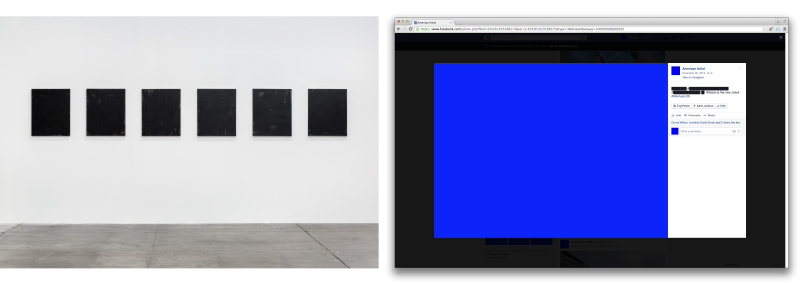
[Left] Fig.7 Cheyney Thompson, Somewhere Some Pictures Sometimes, September 7—October 21 Installation on September 7, 2017 [Right] Fig.8 American Artist, screen capture of A Refusal, 2015-2016, Online Performance.
But at the heart of this resurgence and the blank slate at its foundation lies the belief in a kind of reciprocity in painting—we demand something of it, reflecting in it as in a mirror, or, to venture a psychoanalytic model, as a child is mirrored by the parent. Perhaps this is why the recent “Zombie Formalist” trend identified with tossed off, mass-produced abstract canvases and artists like Lucien Smith, Oscar Murillo, Jacob Kassay and others has been so quickly overturned: as if some deep psychological structure compels us to project love onto a painted surface and expect love in return. We want to be irradiated by the work’s aura, Walter Benjamin suggested, as an infant is bathed in the warm, restorative gaze of its mother. *14 Moreover, this restorative dimension is always the contested zone that determines painting’s generosity or resistance: If the work gives too much, it is smothering and kitschy; not enough and it withholds, refuses, renders our love unrequited. To expose such love, then, is to expose vulnerability in the same way the White Painting series exposes the vulnerability of its willing adorers who love unabashedly.
Within contemporary art’s often cloistered, socially rigid settings such vulnerability may be difficult to show, and so in much recent abstract painting, artists have sought to shield it behind irony, the cool remove of reason or via other means. Others have tried to devalue it by devaluing painting—by treating the monochrome like everyday production, as does Josh Smith, or by hanging and piling it like so many discarded tarps, as does Oscar Murillo. Or consider the many practices that diffuse affect via photo-indexical procedures, as evident in the work of Tauba Auerbach, Wade Guyton’s Epson-printed monochromes or the subtly iridescent canvases of Scott Lyall.
Like THE EUGENE Studio, many artists also seek to converge painting with a technologically inspired, networked realm. In Cheyney Thompson’s recent work, the monochrome is subjected to algorithmic permutations, its pigment load determined by the random walk algorithm—used in such diverse fields as ecology, psychology, computer science and economics—and its shifting configuration within the gallery determined by a biometrically secure punch clock designed by the artist and punched daily by the gallery staff. Meanwhile, Pieter Schoolwerth, whose Model as Painting series (2016-2018) features relief-based figurative monochromes as a kind of memorial to his complex process, recently collaborated with Avery Singer and Alexander Carver, who collectively built a virtual utopian park and responded to this space each with a series of paintings. Like his other work, Schoolwerth’s hybrid tableaus are moored equally in the digital and analog realms, insisting on the inseparability of the two while constantly inscribing the presence of the network in our mediated “once removed” lives.*15 Shifting in another direction, it isn’t surprising that A Refusal (2015-2016) by American Artist—who legally changed his name in a parallel refusal of identity—deployed a blue monochrome to obscure the artist’s social media messages for one year, each post negated with a blank digital rectangle recalling Rodchenko’s Pure Blue Color (1921) as well as cinema’s bluescreen.
Shifting to the obverse of the digital, we also find the monochrome reasserted in starkly analog terms, whether in Jessica Dickinson’s labor-intensive gouged surfaces, or in Sam Moyer’s stone-laden canvases that converge painting with sculpture. In Julia Rommel’s work, the painting is often stretched, painted on its face, sides and back, and then re-stretched in a larger format, in turn developing colorful geometric compositions at whose center lies, what else, but the monochrome. Whether we explore its more tactile and gestural embodiments or its cooler, neutral iterations, all these abstract and abstracting strategies elicit our affective demand of painting while sublimating, displacing or dissimulating the artist’s vulnerability.
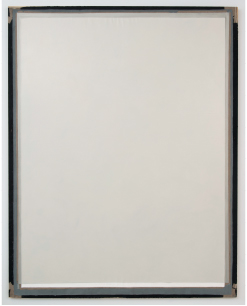
Fig.9 Julia Rommel, Around Woman, 2013. Oil on linen, 77 3/4 × 61 in, 197.5 × 154.9 cm.
But there is one place where people show this vulnerability unabashedly, choosing a mediated forum that ironically provokes unmediated emotion: the Internet with its many broadcast confessions, adorations, fan sites and chatrooms. Today it is not uncommon to log on to YouTube, Instagram or other online platforms and witness uncensored professions, recorded surprise, the experience of apprehending something for the first time, unpacking, reacting, falling in love. Such affective space comprising the minutiae of our digital lives is in sharp contrast to the globalized arena of corporations and world powers, which exploit our affect but articulate emotion in often canned, cartoonish and inhuman ways. Indeed, in contrast to cosmeticized spectacle and network reality shows, the Internet is suffused with minor affect and the kind of “visual bonds” that Hito Steyerl, invoking Dziga Vertov, extolled for their emancipatory potential.*16 Such is also the love at the heart of THE EUGENE Studio’s White Painting trinity, which points through the modernist icon to the Web while resituating painting as a token of collective faith and individual affection. Unlike the ironic strains of conceptual art, zombie devaluations and more conservative abstraction that seeks a return to modernism’s former grandeur, here the love-faith dyad associated with painting is not degraded cynically nor is it mystified as a cipher of the ineffable. Rather, it is exposed for what it is—a product of circulation that forms a constituency with each staging. Like many fan communities online and in analog space, this community is comprised of affective bonds by individuals emotively constellating around a site. That THE EUGENE Studio chooses painting as this principal meeting place highlights the medium’s modern role in secularizing love as human rather than divine and embodied rather than transcendental. Moreover, in doing so, the White Painting series returns the monochrome to its iconic if uncertain place between a portal and a thing—which, like all material things, once charged with the beholder’s passion, becomes limitless.
Annotation
1. See Kazimir Malevich, “Non-Objective Art and Suprematism” (1919), Art in Theory 1900–1990: An Anthology of Changing Ideas, eds. Charles Harrison and Paul Wood (Oxford: Blackwell Publishers, 1992), p. 292.
2. See Aleksandr Rodchenko, “The Death of Painting,” Museum of Modern Art, https://www.moma.org/interactives/exhibitions/1998/rodchenko/texts/death_of_painting.html
3. See Michael Fried’s “Art and Objecthood” (1967). In this seminal piece attacking Minimalism—what Fried calls literalism—he defends the transportive qualities of the autonomous artwork articulated as presentness. “We are all literalists most or all of our lives,” Fried famously wrote, “Presentness is grace.” Art in Theory 1900–1990: An Anthology of Changing Ideas, eds. Charles Harrison and Paul Wood (Oxford: Blackwell Publishers, 1992), p. 832. Originally published in Artforum, Summer 1967.
4. Lawrence Alloway, Robert Rauschenberg (National Collection of Fine Arts, Smithsonian Institution, 1976), p. 3. https://www.moma.org/documents/moma_catalogue_2392_300062510.pdf
5. Douglas Crimp, “The End of Painting,” October 16 (Spring 1981), p. 77.
6. Ibid, p. 73.
7. For more on this, see Thomas McEvilley, The Exile’s Return: Towards as Redefinition of Painting in the Post-Modern Era (Cambridge University Press 1993), p. 55.
8. See Pierre Bourdieu, The Field of Cultural Production, ed. Randall Johnson (Columbia University Press 1993).
9. See Thomas Lawson, “Last Exit: Painting” in Theories of Contemporary Art, ed. Richard Hertz (New Jersey, Prentice-Hall, 1985), p. 143. Originally published in Artforum (October 1981).
10. Ibid, p 152.
11. Douglas Crimp, “The End of Painting,” October 16 (Spring 1981), p. 80-81.
12. I borrow this term from Michael Fried. See, again, his “Art and Objecthood” (1967), Art in Theory 1900–1990: An Anthology of Changing Ideas, eds. Charles Harrison and Paul Wood (Oxford: Blackwell Publishers, 1992), p. 832.
13. Thomas McEvilley, The Exile’s Return: Towards as Redefinition of Painting in the Post-Modern Era (Cambridge University Press 1993), p. 51.
14. As Benjamin writes, “The person we look at, or who feels he is being looked at, looks at us in turn. To perceive the aura of an object we look at means to invest it with the ability to look at us in return.” See Walter Benjamin, “On Some Motifs in Baudelaire” (1939), in Illuminations, trans. Harry Zohn (New York: Schocken Books, 1977), p. 188. Also see Hal Foster, The Return of the Real (MIT Press 1996), p. 267.
15. See Pieter Schoolwerth, “Depicting the World ‘Once Removed,’” lecture, VCS Art in the First-Person Lecture Series, School of Visual Arts, December 4, 2017, https://www.youtube.com/watch?v=qLM3MTJ5uSM.
16. See Hito Steyerl, “In Defense of the Poor Image,” e-flux, Journal #10, November 2009, https://www.e-flux.com/journal/10/61362/in-defense-of-the-poor-image/.
Other thesis
“Malevich’s “Black Square” consists of various elements amenable to aesthetic interpretation gathered together on the canvas (material medium) itself, while by contrast, in “White Painting,” the canvas (material medium), accompanied by elements external to the medium itself, provides the key to linking this work to the everyday of the real world. …The contemporary relevance of “White Painting” can be said to be in its nature of having direct connections to the world outside the “painting” (i.e. the everyday nature of the real-life world).”

